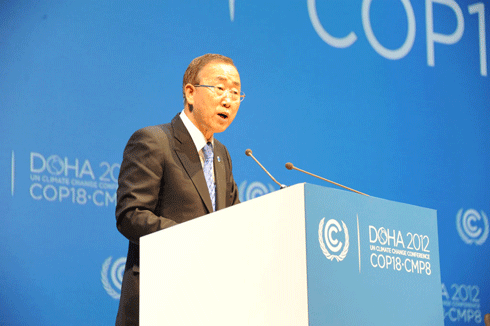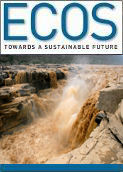
|
Published: 11 December 2012
Doha clears tentative path to 2015 global agreement
The Doha Climate Summit concluded with an agreement to streamline negotiations towards a new legally binding agreement by 2015. According to The Climate Institute, this locks both of Australia’s major political parties into their promises of up to 25 per cent emission reductions by 2020.

|
|
UN Secretary-General Ban Ki-moon addresses 18th Conference of the Parties (COP) to the UN Framework Convention on Climate Change. Credit:
UNFCCC
|
‘Doha was a difficult meeting but it has cleared a tentative path to a 2015 global agreement that covers all major emitters,’ said Erwin Jackson, Deputy CEO, The Climate Institute from Doha.
‘The meeting has ensured the future of the Kyoto Protocol as a stepping stone to a global agreement as well as process to increase international scrutiny of Australia's 2020 emission targets and climate finance contributions.’
CEO John Connor added: ‘The next two years will test the credibility of both major parties’ emission commitments and their readiness to achieve more than the minimum 5 per cent 2020 target. There will be public tests in 2013 and early, mid and late 2014.
‘Scrutiny will also focus on how Australia will provide the public and private financing needed to build resilience to growing climate impacts and help the world's poorest nations reduce industrial and deforestation emissions.’
Jackson continued that,‘Doha is not all upside. Many of the specific elements of the agreement are modest.
‘While the outcomes allow a clear focus on the new 2015 binding agreement, to a great extent it has been business as usual for global climate politics. It is clear that for an ambitious outcome in 2015 to be delivered then the ambition and spirit of cooperation countries bring to these meetings needs a reset.
‘Analysis of current international action by Professor Garnaut, ANU and The Climate Institute indicates that a 10-15 per cent reduction is the nation's fair commitment based on current pledges from other major emitters
‘Australia's fair share in a world limiting climate change to safer levels is a 25 per cent reduction by 2020.
‘The world is moving to drive clean energy and low pollution investment to meet the targets they have set, deliver energy security and build new clean industries.’
Concluded Connor: ‘Collective action however has not reached levels that address the gap between the action being taken and what is needed to limit climate change to safer levels.’
Elements of the Doha agreement also include:
-
Agreement to implement Kyoto's second commitment period from the 1st January next year: The Climate Institute welcomes Australia's participation in the new round of Kyoto targets. As an important gesture of good faith, Australia should table the new treaty arrangements in the
first week of Parliament next year to ensure speed ratification of the amendments. Kyoto targets will be re-examined with a view to increase ambition in 2014. Indications of increased ambition are to be submitted by 30 April 2014. -
A commitment to scale up to the US$100 billion 2020 commitment on climate finance: Australia has yet to indicate the scale of its ongoing climate finance contribution. European Union countries pledged approximately $7.5 billion over the next couple of years in Doha. By the end of 2013, Australia will need to show the world it has clear plan to increase its climate finance. This will be put under the international spotlight and examined by a ministerial meeting at the end of 2013.
-
Increasing ambition: Outside Kyoto, a number of political and technical processes have been initiated to encourage and incentivise great ambition before 2020. This includes a review of adequacy of the global goal of 2 degrees Celsius average increase, and a world leader summit to be convened by the UN Secretary General in 2014.
Source: The Climate Institute



